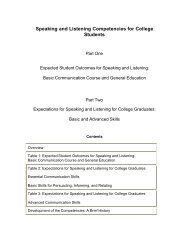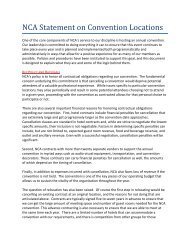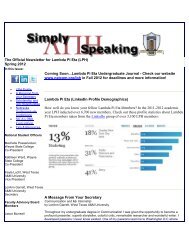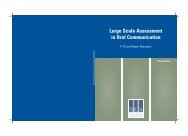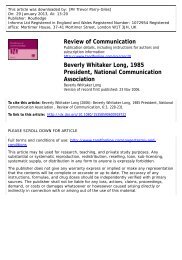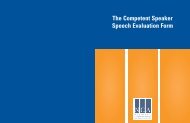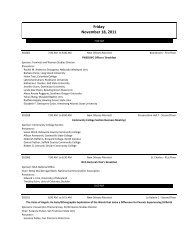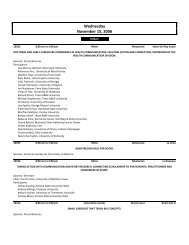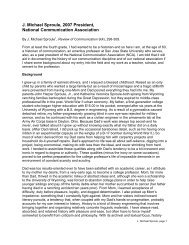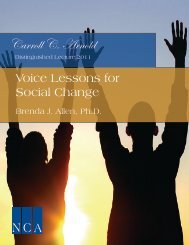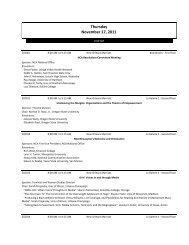Assessing Motivation to Communicate - National Communication ...
Assessing Motivation to Communicate - National Communication ...
Assessing Motivation to Communicate - National Communication ...
- No tags were found...
You also want an ePaper? Increase the reach of your titles
YUMPU automatically turns print PDFs into web optimized ePapers that Google loves.
Sources:Beatty, M.J., McCroskey, J.C., & Heisel, A.D. (1998) <strong>Communication</strong>apprehension as temperamental expression:A communibiological paradigm. <strong>Communication</strong> Monographs,65, 197-219.Morreale, S., Spitzberg, B., & Barge, K. (2006). Human communication:<strong>Motivation</strong>, knowledge, and skills. Belmont,CA: Thomson Wadsworth.II. FACT SHEET ABOUT THIS PROGRAMContents of the program and twoinstrumentsThis program contains two assessment instruments,the Personal Report of <strong>Communication</strong> Apprehension(PRCA) and the Willingness <strong>to</strong> <strong>Communicate</strong> (WTC).The instruments are presented in hard copy in this manualand on a Web site: http://www.uccs.edu/~webdept/excel/comm_prepost/index.php. As the descriptions ofthe two instruments below indicate, both are highly reliableand valid for measuring two dimensions of themotivational domain of communication competence.Personal Report of <strong>Communication</strong>Apprehension (PRCA-24)The PRCA-24 is the instrument that is most widelyused <strong>to</strong> measure communication apprehension. It ispreferable above all earlier versions of the instrument(PRCA, PRCA10, PRCA-24B, etc.). It is highly reliable(alpha regularly >.90) and has very high predictivevalidity. It permits one <strong>to</strong> obtain sub-scores onthe contexts of public speaking, dyadic interaction,small groups, and large groups. However, these scoresare substantially less reliable than the <strong>to</strong>tal PRCA-24scores because of the reduced number of items. Peopleinterested only in public speaking anxiety should considerusing the PRPSA rather than the public speakingsub-score drawn from the PRCA-24. It is much morereliable for this purpose.Willingness <strong>to</strong> <strong>Communicate</strong> (WTC)Willingness <strong>to</strong> communicate is the most basic orientation<strong>to</strong>ward communication. Almost anyone is likely<strong>to</strong> respond <strong>to</strong> a direct question, but many will not continuethe conversation or actually initiate an interaction.This instrument measures a person’s willingness <strong>to</strong> initiatecommunication. The face validity of the instrumentis strong, and results of extensive research indicate thepredictive validity of the instrument. Alpha reliabilityestimates for this instrument have ranged from .85 <strong>to</strong>well above .90. Of the 20 items on the instrument, 8 areused <strong>to</strong> distract attention from the scored items. The 12remaining items generate a <strong>to</strong>tal score, four context-typescores, and three receiver-type scores. The sub-scoresgenerate lower reliability estimates, but generally highenough <strong>to</strong> be used in research studies.His<strong>to</strong>ry and description of this programThis program, <strong>Assessing</strong> <strong>Motivation</strong> <strong>to</strong> <strong>Communicate</strong>,has been available through the <strong>National</strong> <strong>Communication</strong>Association for over 15 years. In its original form,the purchaser received hard copies of the instrumentsand a packet of articles describing the two instrumentsand their use in research and pedagogy. In this secondedition, the instruments are provided on a Web site <strong>to</strong>facilitate ease of administration; and, relevant researcharticles are provided in annotated form so the administra<strong>to</strong>rhas easy access <strong>to</strong> any needed background informationabout the instruments. While these instrumentsare available in the public domain, the second editionof this program is intended <strong>to</strong> provide everything, all inone place, that any administra<strong>to</strong>r or instruc<strong>to</strong>r needs <strong>to</strong>use these <strong>to</strong>ols effortlessly.Recommendations for using the programThis program and the instruments it contains may beused for several purposes.(a) Given the importance of motivation as a par<strong>to</strong>f communication competence, these instrumentsmay be used <strong>to</strong> assess two dimensions ofthe motivational domain of students – negative(PRCA) and positive motivation (WTC). Eitheror both instruments could be administered at thebeginning of a course <strong>to</strong> ascertain students’ levelof motivation; or, at the beginning and end of acourse as a pre-post test comparison.(b) Either or both instruments may be used for testing-inor testing-out (placement) purposes. For example,students with high levels of apprehension or8 <strong>Assessing</strong> <strong>Motivation</strong> <strong>to</strong> <strong>Communicate</strong>




